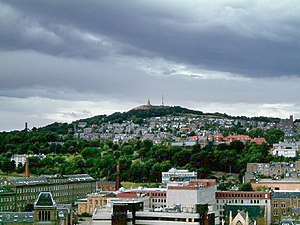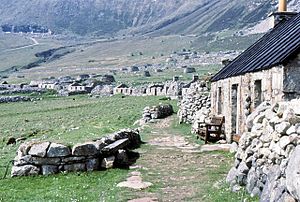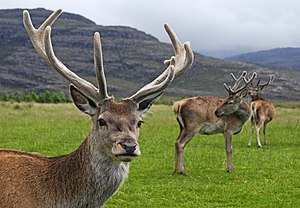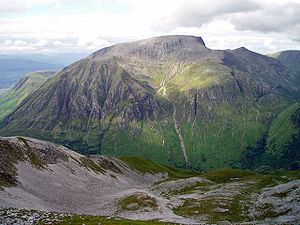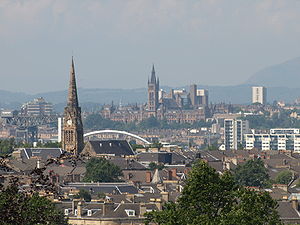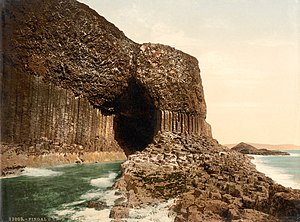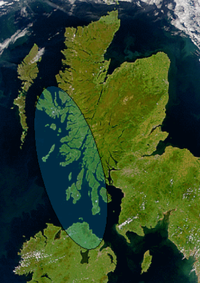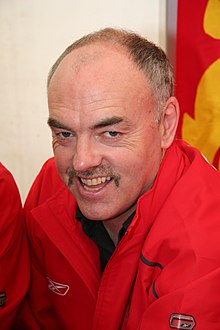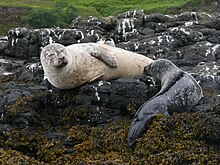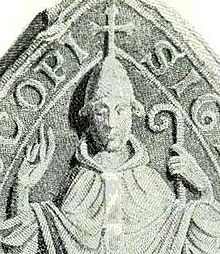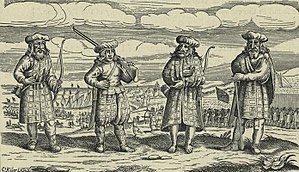User:Cactus.man/Sandbox/P-Sco/Selected articles
The Scotland Portal
| Main Page | Selected articles | Selected biographies | Selected quotes | Selected pictures | Featured Content | Categories & Topics |
Hand picked articles 1
Hand picked articles 2
Featured articles
Featured articles

The economy of Scotland in the Middle Ages covers all forms of economic activity in the modern boundaries of Scotland, between the End of Roman rule in Britain in the early fifth century, until the advent of the Renaissance in the early sixteenth century, including agriculture, crafts and trade. Having between a fifth or sixth (15-20 %) of the arable or good pastoral land and roughly the same amount of coastline as England and Wales, marginal pastoral agriculture and fishing were two of the most important aspects of the Medieval Scottish economy. With poor communications, in the early Middle Ages most settlements needed to achieve a degree of self-sufficiency in agriculture. Most farms were operated by a family unit and used an infield and outfield system.
Arable farming grew in the High Middle Ages and agriculture entered a period of relative boom between the thirteenth century and late fifteenth century. Unlike England, Scotland had no towns dating from times of Roman Britain. From the twelfth century there are records of burghs, chartered towns, which became major centre of crafts and trade. There are also Scottish coins, although English coinage probably remained more significant in trade, and until the end of the period barter was probably the most common form of exchange. Craft and industry remained relatively undeveloped before the end of the Middle Ages and, although there were extensive trading networks based in Scotland, while the Scots exported largely raw materials, they imported increasing quantities of luxury goods, resulting in a bullion shortage and perhaps helping to create a financial crisis in the fifteenth century. (Full article...)
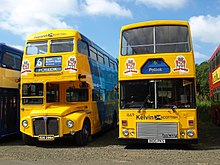
Kelvin Scottish Omnibuses Ltd was a bus operating subsidiary of the Scottish Transport Group based in Bishopbriggs, Strathclyde, Scotland. It was formed in March 1985 from parts of Walter Alexander & Sons (Midland) Ltd and Central SMT, initially with six depots and a varied fleet of 381 vehicles.
The company expanded its operations in Glasgow prior to bus deregulation in 1986. New services were introduced in competition with Strathclyde Buses, many using AEC Routemaster double-deckers operated by conductors. Kelvin suffered from vehicle maintenance problems, and on two occasions was forced to hire vehicles from other companies to ensure operation of all its routes. After Kelvin lost money in 1987, the depot at Milngavie was closed and many routes withdrawn. (Full article...)
McEwan's is a brand of beer owned by Carlsberg Marston's Brewing Company. It was originally brewed by William McEwan's Fountain Brewery in Edinburgh, Scotland. The McEwan's brand passed to Heineken in 2008 after their purchase of Scottish & Newcastle's British operations. Heineken sold the brand to Wells & Young's in 2011, who sold their brewing operation, including the McEwan brand to Marston's in 2017. Cans and bottles are now brewed in Bedford, England. (Full article...)

Art in early modern Scotland includes all forms of artistic production within the modern borders of Scotland, between the adoption of the Renaissance in the early sixteenth century to the beginnings of the Enlightenment in the mid-eighteenth century.
Devotional art before the Reformation included books and images commissioned in the Netherlands. Before the Reformation in the mid-sixteenth century the interiors of Scottish churches were often elaborate and colourful, with sacrament houses and monumental effigies. Scotland's ecclesiastical art paid a heavy toll as a result of Reformation iconoclasm, with the almost total loss of medieval stained glass, religious sculpture and paintings. (Full article...)
}
'"`UNIQ--templatestyles-00000042-QINU`"'
'"`UNIQ--references-00000043-QINU`"'
Source: (Full article...)
'"`UNIQ--templatestyles-00000042-QINU`"'
'"`UNIQ--references-00000043-QINU`"'
Source: (Full article...)
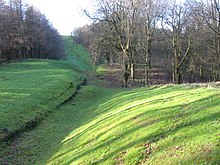
The architecture of Scotland in the Roman era includes all building within the modern borders of Scotland, from the arrival of the Romans in northern Britain in the first century BCE, until their departure in the fifth century CE. Ptolemy indicated that there were 19 "towns" in Caledonia, north of the Roman province of Britannia, but no clear evidence of urban settlements has been found and these were probably hillforts. There is evidence of over 1,000 such forts, most south of the Clyde-Forth line, but the majority seem to have been abandoned in the Roman period. There is also evidence of distinctive stone wheelhouses and small underground souterrains.
From about 71 CE the Romans began military expeditions into what is now Scotland, building forts, like that at Trimontium, and probably pushing north as far as the River Tay where they created more fortifications, like those at Inchtuthil. These were soon abandoned, and the Romans settled for the occupation of the Southern Uplands by the end of the first century, south of a line drawn between the Tyne and Solway Firth. This resulted in more fortifications and the building of Hadrian's Wall across what is now northern England. Around 141 CE they moved up to construct a new limes, a sward-covered wall made of turf known as the Antonine Wall, the largest Roman structure in modern Scotland. They soon retreated to Hadrian's Wall, with occasional expeditions that involved the building and reoccupation of forts, until the collapse of Roman power in the early fifth century. (Full article...)
The water bull, also known as tarbh-uisge in Scottish Gaelic, is a mythological Scottish creature similar to the Manx tarroo ushtey. Generally regarded as a nocturnal resident of moorland lochs, it is usually more amiable than its equine counterpart the water horse, but has similar amphibious and shapeshifting abilities.
The water bull is said to reproduce with standard cattle, the resulting progeny distinguishable by the small size of their ears. According to some myths, the calves of water bulls and ordinary cows ought to be killed at birth by any method other than drowning – they cannot be killed by drowning – to avoid bringing disaster to the herd. Conversely, in northern areas the calves are considered to be of superior quality. (Full article...)
The water bull is said to reproduce with standard cattle, the resulting progeny distinguishable by the small size of their ears. According to some myths, the calves of water bulls and ordinary cows ought to be killed at birth by any method other than drowning – they cannot be killed by drowning – to avoid bringing disaster to the herd. Conversely, in northern areas the calves are considered to be of superior quality. (Full article...)

The treasure of Loch Arkaig, sometimes known as the Jacobite gold, was a large amount of specie provided by Spain to finance the Jacobite rising in Scotland in 1745, and rumoured still to be hidden at Loch Arkaig in Lochaber. (Full article...)
The National is a Scottish daily newspaper owned by Newsquest. It began publication on 24 November 2014, and was the first daily newspaper in Scotland to support Scottish independence. Launched as a response to calls from Newsquest's readership for a pro-independence paper in the wake of the 2014 Scottish independence referendum, it is a sister paper of The Herald, and is edited by Laura Webster. Initially published on weekdays, a Saturday edition was added in May 2015. The National is printed in tabloid format, and is also available via online subscription.
Details of its launch were announced on 21 November, with further information given at a Scottish National Party (SNP) rally the following day. It was launched on a five-day trial basis against the backdrop of a general decline in newspaper sales, with an initial print-run of 60,000 copies for its first edition, but this was increased the following day as a result of public demand, and Newsquest decided to print it on a permanent basis after healthy sales continued throughout the first week. The first front page carried a story about charities urging devolution of powers over welfare legislation to Scotland. (Full article...)
Details of its launch were announced on 21 November, with further information given at a Scottish National Party (SNP) rally the following day. It was launched on a five-day trial basis against the backdrop of a general decline in newspaper sales, with an initial print-run of 60,000 copies for its first edition, but this was increased the following day as a result of public demand, and Newsquest decided to print it on a permanent basis after healthy sales continued throughout the first week. The first front page carried a story about charities urging devolution of powers over welfare legislation to Scotland. (Full article...)
Islay (/ˈaɪlə/ EYE-lə; Scottish Gaelic: Ìle, Scots: Ila) is the southernmost island of the Inner Hebrides of Scotland. Known as "The Queen of the Hebrides", it lies in Argyll just south west of Jura and around 40 kilometres (22 nautical miles) north of the Northern Irish coast. The island's capital is Bowmore where the distinctive round Kilarrow Parish Church and a distillery are located. Port Ellen is the main port.
Islay is the fifth-largest Scottish island and the eighth-largest island of the British Isles, with a total area of almost 620 square kilometres (240 sq mi). There is ample evidence of the prehistoric settlement of Islay and the first written reference may have come in the first century AD. The island had become part of the Gaelic Kingdom of Dál Riata during the Early Middle Ages before being absorbed into the Norse Kingdom of the Isles. (Full article...)
}
'"`UNIQ--templatestyles-000000AB-QINU`"'
'"`UNIQ--references-000000AC-QINU`"'
Source: (Full article...)
'"`UNIQ--templatestyles-000000AB-QINU`"'
'"`UNIQ--references-000000AC-QINU`"'
Source: (Full article...)
Hampden Park (Scottish Gaelic: Pàirc Hampden) is a football stadium in the Mount Florida area of Glasgow, Scotland, which is the national stadium of football in Scotland and home of the Scotland national football team. Hampden Park is owned by the Scottish Football Association (SFA), and regularly hosts the latter stages of the Scottish Cup and Scottish League Cup. A UEFA category four stadium, Hampden Park has hosted six European finals including the 1960 European Cup final between Real Madrid and Eintracht Frankfurt which, with a crowd of 127,621 in attendance, is the highest ever recorded attendance for a European Cup final.
The stadium has hosted other sporting events including the 2012 Olympic Games and the 2014 Commonwealth Games (also hosting the 2014 Commonwealth Games closing ceremony). Scotland was one of the eleven host countries of the pan–European Euro 2020 tournament, and as a result, Hampden Park hosted the round of 16 matches and will host matches of the upcoming Euro 2028, of which Scotland is again one of the host countries. The largest stadium by capacity when opened in 1903, an accolade the stadium held until 1950, Hampden Park is the 50th largest football stadium in Europe, the 11th largest in the United Kingdom, and the second largest football stadium in Scotland. The stadium retains all attendance records recorded in European football. (Full article...)
On 9 July 1872 the Tradeston Flour Mills, in Glasgow, Scotland, exploded. Eighteen people died, and at least sixteen were injured. An investigation suggested that the explosion was caused by the grain feed to a pair of millstones stopping, causing them to rub against each other, resulting in a spark or fire igniting the grain dust in the air. That fire was then drawn by a fan into an "exhaust box" designed to collect grain dust, which then ignited, causing a second explosion which destroyed the building. At the time, there were general concerns about similar incidents worldwide, so the incident and investigation were widely reported across the world. (Full article...)
Lochleven Castle is a ruined castle on an island in Loch Leven, in the Perth and Kinross local authority area of Scotland. Possibly built around 1300, the castle was the site of military action during the Wars of Scottish Independence (1296–1357). In the latter part of the 14th century, the castle was granted to William Douglas, 1st Earl of Douglas, by his uncle. It remained in the Douglases' hands for the next 300 years. Mary, Queen of Scots, was imprisoned there in 1567–68, and forced to abdicate as queen, before escaping with the help of her gaoler's family. In 1588, the queen's gaoler inherited the title of Earl of Morton, and moved away from the castle. In 1675, Sir William Bruce, an architect, bought the castle and used it as a focal point for his garden; it was never again used as a residence.
The remains of the castle are protected as a scheduled monument in the care of Historic Environment Scotland. Lochleven Castle is open to the public in summer, and access is available by ferry. (Full article...)

Pte. Andrew Ross (15 May 1879 – 6 April 1916) was a Scottish rugby union player from Edinburgh. He worked in the Merchant Navy as a marine engineer. He played for Royal High School FP and was capped several times for Scotland between 1905 and 1909.
In 1910, Ross moved to Vancouver and enlisted with the Canadian Expeditionary Force after the First World War broke out, and was sent to Belgium with the 29th Canadians (Tobin's Tigers). Wounded during the Actions of St Eloi Craters, Ross risked his life to aid other wounded men under heavy fire when he was hit by a shell and killed. He is buried in Ridge Wood Military Cemetery, Belgium. (Full article...)
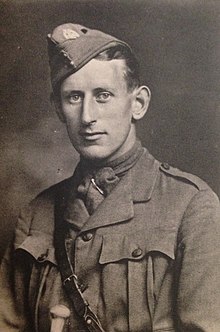
William "Willie" Middleton Wallace (23 September 1892 – 22 August 1915) was a rugby union player. He played fullback for Cambridge University RFC and was capped for Scotland in 1913–14.
Having grown up in Edinburgh, Willie Wallace went to King's College, Cambridge in 1912, where he was immediately noticed for his rugby-playing ability. He was selected to play against Oxford in the Varsity Match in his first term. Later in the season, in March 1913, Scotland picked him to play away against England, in a close game, which England won by just three points. The following season he played in all three Home Nations matches against Wales, Ireland and England. (Full article...)
SS Manasoo (originally named Macassa) was a steel-hulled Canadian passenger and package freighter in service between 1888 and 1928. She was built in 1888 in Port Glasgow, Scotland, by William Hamilton & Company for the Hamilton Steamboat Company of Hamilton, Ontario, who used her as a passenger transport between Hamilton and Toronto, Ontario. Macassa was lengthened in Collingwood, Ontario, in 1905. She was sold twice before being sold to the Owen Sound Transportation Company, Ltd., and was rebuilt and renamed Manasoo; after the sale, she mainly operated between Sault Ste. Marie and Owen Sound, Ontario.
After a lucrative shipping season in 1928, Manasoo was open to take on special commissions. On September 14, she left the Manitoulin Island port of Manitowaning, Ontario, under the command of Captain John McKay. There were nineteen crewmen, two passengers, 115 cows and one bull on board. By the time Manasoo had cleared the North Channel of Lake Huron, a sizeable storm had developed. By 2:00 a.m. the next day, Manasoo had begun to list to port. Despite efforts to correct it, the list worsened. As she was off Griffith Island, Manasoo rolled over and sank. Five crewmen and one passenger climbed onto a life raft; one of the crew later died of exposure, while the rest were rescued by the steamer Manitoba. Sixteen people died in the wreck. (Full article...)

Education in Medieval Scotland includes all forms of education within the modern borders of Scotland, between the departure of the Romans from Britain in the fifth century, until the establishment of the Renaissance late fifteenth century and early sixteenth century. Few sources on Scottish education survived the Medieval era. In the early Middle Ages, Scotland was an oral society, with verbal rather than literary education. Though there are indications of a Gaelic education system similar to that of Ireland, few details are known. The establishment of Christianity from the sixth century brought Latin to Scotland as a scholarly and written language. Monasteries served as major repositories of knowledge and education, often running schools.
In the High Middle Ages, new sources of education arose, such as song and grammar schools designed to train priests with emphases on music and Latin grammar, respectively. The number and size of these schools expanded rapidly after the 1380s. By the end of the Middle Ages, all the main burghs and some small towns had grammar schools. Educational provision was probably much weaker in rural areas, but there were petty or reading schools in rural areas, providing an elementary education. There was also the development of private tuition in the families of lords and wealthy burghers that sometimes developed into "household schools". Girls of noble families were taught in nunneries and by the end of the fifteenth century Edinburgh also had schools for girls. There is documentary evidence for about 100 schools of these different kinds before the Reformation. The Education Act 1496 decreed that all sons of barons and freeholders of substance should attend grammar schools to learn "perfyct Latyne". All this resulted in an increase in literacy, with perhaps 60 per cent of the nobility being literate by the end of the period. (Full article...)





